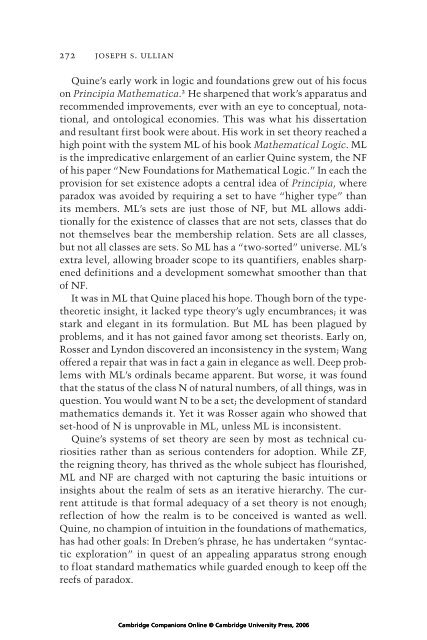Willard Van Orman Quine
Willard Van Orman Quine
Willard Van Orman Quine
You also want an ePaper? Increase the reach of your titles
YUMPU automatically turns print PDFs into web optimized ePapers that Google loves.
272 joseph s. ullian<br />
<strong>Quine</strong>’s early work in logic and foundations grew out of his focus<br />
on Principia Mathematica. 2 He sharpened that work’s apparatus and<br />
recommended improvements, ever with an eye to conceptual, notational,<br />
and ontological economies. This was what his dissertation<br />
and resultant first book were about. His work in set theory reached a<br />
high point with the system ML of his book Mathematical Logic.ML<br />
is the impredicative enlargement of an earlier <strong>Quine</strong> system, the NF<br />
of his paper “New Foundations for Mathematical Logic.” In each the<br />
provision for set existence adopts a central idea of Principia, where<br />
paradox was avoided by requiring a set to have “higher type” than<br />
its members. ML’s sets are just those of NF, but ML allows additionally<br />
for the existence of classes that are not sets, classes that do<br />
not themselves bear the membership relation. Sets are all classes,<br />
but not all classes are sets. So ML has a “two-sorted” universe. ML’s<br />
extra level, allowing broader scope to its quantifiers, enables sharpened<br />
definitions and a development somewhat smoother than that<br />
of NF.<br />
It was in ML that <strong>Quine</strong> placed his hope. Though born of the typetheoretic<br />
insight, it lacked type theory’s ugly encumbrances; it was<br />
stark and elegant in its formulation. But ML has been plagued by<br />
problems, and it has not gained favor among set theorists. Early on,<br />
Rosser and Lyndon discovered an inconsistency in the system; Wang<br />
offered a repair that was in fact a gain in elegance as well. Deep problems<br />
with ML’s ordinals became apparent. But worse, it was found<br />
that the status of the class N of natural numbers, of all things, was in<br />
question. You would want N to be a set; the development of standard<br />
mathematics demands it. Yet it was Rosser again who showed that<br />
set-hood of N is unprovable in ML, unless ML is inconsistent.<br />
<strong>Quine</strong>’s systems of set theory are seen by most as technical curiosities<br />
rather than as serious contenders for adoption. While ZF,<br />
the reigning theory, has thrived as the whole subject has flourished,<br />
ML and NF are charged with not capturing the basic intuitions or<br />
insights about the realm of sets as an iterative hierarchy. The current<br />
attitude is that formal adequacy of a set theory is not enough;<br />
reflection of how the realm is to be conceived is wanted as well.<br />
<strong>Quine</strong>, no champion of intuition in the foundations of mathematics,<br />
has had other goals: In Dreben’s phrase, he has undertaken “syntactic<br />
exploration” in quest of an appealing apparatus strong enough<br />
to float standard mathematics while guarded enough to keep off the<br />
reefs of paradox.<br />
Cambridge Companions Online © Cambridge University Press, 2006
















